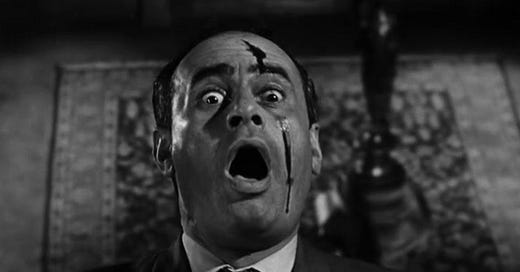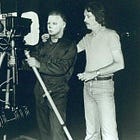In the recent episode of Public Domain Theater on Nosferatu,
and I discussed the strange phenomenon of film professors/historians/buffs who regard every aspect of a classic film as intentional, effective, and basically perfect. The fact is, every great movie has janky shots, or dumb lines, or something.So, today I wanted to talk about two more examples that have bothered me for literally decades—Psycho and The Matrix.
As an aside, we’ll be recording a new episode of PDT tomorrow, aboutone of David Bordwell’s Ten Best Films of 1924. Be sure to subscribe, so you don’t miss it!
It rolls down stairs, alone or in pairs
I love Psycho. It’s one of my favorite movies of all time. The essay I wrote to get into film school was about the thematic lineage from Psycho to Halloween to Scream.1 I’ve watched Psycho at least a hundred times, and I never get tired of it. It’s a near-perfect movie.
But it’s not perfect.
Although not as celebrated as the shower scene, [spoiler alert for a 65 year old movie] Arbogast’s death is one of the tensest sequences in the film. If you haven’t seen it in a while, check it out—
Here’s what François Truffaut and Hitch had to say about the shot of him falling down the staircase—
F.T. I was rather intrigued by that fall backward. He doesn’t actually fall. His feet aren’t shown, but the feeling one gets is that he’s going down the stairs backward, brushing each step with the tip of his foot, like a dancer.
A.H. That’s the impression we were after. Do you know how we got that?
F.T. I realize you wanted to stretch out the action, but I don’t know how you did it.
A.H. We did it by process. First I did a separate dolly shot down the stairway, without the man. Then we sat him in a special chair in which he was in a fixed position in front of the transparency screen showing the stairs. Then we shot the chair, and Arbogast simply threw his arms up, waving them as if he’d lost his balance.
F.T. It’s extremely effective.
I don’t know what’s more shocking, the fact that Truffaut didn’t know how it was done, or that he thought it was effective.
He doesn’t look like he’s “brushing each step with the tip of his foot, like a dancer.” He looks like he’s waving his arms in front of a rear-projection screen…which is exactly what he’s doing.
It’s really, really dumb looking. Just fake and dumb. No French New Wave critic-turned director is going to convince me otherwise.
And that’s okay.
Just because it’s a Hitchcock movie, doesn’t mean we have to accept the shot is perfectly executed, but the poor effect doesn’t have to ruin the filmgoing experience, either. It’s just a little bump, that’s all. We forget about it almost immediately with the next shot, the close-up of the knife. Then the movie goes on to the next scene, between Lila Crane and Sam Loomis,2 and we get swept up in the story again. That’s part of what makes a great movie great—you don’t even remember the mistakes.
As an aside, if you like Hitchcock and his influence, watch my video essay on Halloween, which was greatly influenced by Psycho. Plus, there’s a few extra Hitchcock tidbits in the notes section of the article—
Who Writes This?
Astoundingly innovative, if not quite revolutionary, The Matrix is still one of the best sci-fi films ever made. I say “still,” because did you realize it came out more than a quarter century ago?
The action, the effects, the costumes—it’s all still very cool, lo these many years later. You know what’s not still cool (and honestly, never was)? A lot of the dialogue.
This film had two writers. Eight producers. Who knows how many studio executives demanded fourteen drafts of the screenplay. And still, poor Joe Pantoliano had to show up on set, look at his sides and shrug: “I guess I can say that.”
What does Dorothy have to do with seatbelts? And Kansas is going “bye-bye”? Is that supposed to be tough-guy dialogue? Joey Pants sells it as best he can, but man, he shouldn’t have to.
And as dumb as that line is, I find this exchange a thousand times more aggravating—
First of all, the phrase “killing machine designed only for one thing” already implies what that “one thing” is—killing. That’s what the machine is designed for. A sewing machine is for sewing, a vending machine is for vending, and a killing machine is for killing.
It’s not a question. The line doesn’t require an answer. But we get one anyway, and it’s arguably the dumbest possible response. “Search and destroy” is two things. TWO. You know how I know? Because of the word and right in the middle there.
The Matrix gets away with a lot, because it’s got style. And like Psycho, I wouldn’t remember these lines if I hadn’t re-watched it over and over, because taken as a whole, the movie is awesome.3
Wabi-sabi
I don’t know if Hitchcock or the Wachowskis intentionally included these flaws as a commentary on the inherent imperfection of human life and art.4 But I still love Psycho and The Matrix, despite these minor defects.
Have you had this experience? What’s a minor fault in an other great movie you enjoy? Leave a comment!
Also, don’t forget to hit the little heart icon, because that helps the Substack algorithm show Too Much Film School to new readers.
Interestingly, these are all 18 years apart, which means one could make a generational connection from Cat People (1942) to It Follows (2014).
“Loomis” being a name that shows up later in both in Halloween and Scream.
It’s also dumb in a lot of ways, but this post is already too long, so I’ll write a follow-up piece on the whole battery thing another day.
They didn’t.




![Timeline 1 copy.gif [optimize output image] Timeline 1 copy.gif [optimize output image]](https://substackcdn.com/image/fetch/w_1456,c_limit,f_auto,q_auto:good,fl_lossy/https%3A%2F%2Fsubstack-post-media.s3.amazonaws.com%2Fpublic%2Fimages%2Fdfde113e-27d8-499b-beb3-e582d37d50f5_768x432.gif)



At the end of the Wizard of Oz, the Scarecrow states a mathematical equation that's wrong. I hate that. "Isosceles" triangle sounds better than "right" triangle, which I'm sure is why they had him say that, but they could have asked any math student to give a complicated-sounding equation that was actually correct.
In The Princess Bride, the moment that Buttercup realizes that the masked man is Wesley is poorly edited. It’s too quick. We need a few seconds to watch her figure it out, but in the movie it happens literally instantaneously.